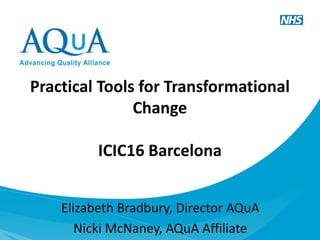1.6 practical tools for transformational change - bradbury and mc naney (453)
- 1. Practical Tools for Transformational Change ICIC16 Barcelona Elizabeth Bradbury, Director AQuA Nicki McNaney, AQuA Affiliate
- 2. Objectives • Explore approaches to behavioural and technical change • Discuss use and alignment of improvement tools and techniques • Explore building improvement capability across systems 2
- 3. Established in 2010 as a NHS health and care quality improvement organisation. Based in North West England Members: 73 commissioner and provider organisations Hosted by Salford Royal Foundation Trust and accountable to: - AQuA’s Board - AQuA members through membership agreements Extensive work on integration and transformation www.AQuAnw.nhs.uk About AQuA
- 4. AQuA’s Integrated Care and Transformation Story 4 Leading System-Level Integrated Care Integrated Care International Exchange Programme Integrated Care Fellowship Programme 2014-152012-14 Integration Discovery Communities Transformat- ional Change Programme Integrated Care & Frailty Networks Bespoke locality support Masterclass series 2015-16 System Development 2016-17 Bespoke place based facilitation and expert coaching Masterclass series
- 5. AQuA’s System Integration Framework © AQuA Action 2012 Integration to Improve • Safety • Experience • Effectiveness • Population health • Use of resources Service and Care Model Design Service User and Carer Engagement Leadership Workforce • Role design • Skills • Capacity Information and Information Technology Financial and Contractual Mechanisms Culture Healthcare value Governance
- 6. 6 Integrated Teams Integrated Services Integrated Systems Focus on population outcomes and system enablers Focus on redesigning integrated clinical and support services Focus on redesigning direct care for patients and carers in all settings Understanding Integrated Systems
- 8. 8 What are the integration challenges that you are trying to solve? What tools and techniques are you currently using? How are you building capability for transformational change?
- 10. 10 Integrated Teams Integrated Services Integrated Systems Focus on population outcomes and system enablers System development
- 11. Emerging Model of Large Scale Change Source: Paul Plsek (2008) on behalf of the Academy for Large Scale Change Identifying need for change Framing/ reframing the issues Engaging/ connecting others Making pragmatic change in multiple processes Attracting further interest After some time Settling in Possible outcomes 1. sustainable norm 2. plateau 3. run out of energy Living with results and consequences Maybe later Repeats many times in hard to predict ways Time delay
- 13. A good enough plan 13Source: Integrated Care for Older People in Salford Salford’s Integrated Care Model and Operational Plan, June 2011
- 14. 14 Measures Integrated Care for Older People in Salford Salford’s Integrated Care Model and Operational Plan, June 2011
- 15. Simple rules or minimum specifications Making better decisions: • Boundary rules (inclusion/exclusion) • Prioritising rules (consider alternatives) • Stopping rules (investments and innovations) Doing things better: • How to rules • Co-ordination rules (flocking) • Timing rules Source: Eisenhardt, K. and Ascherman, S.W. (2015)
- 16. 16 In pairs: Agree 3 simple rules for designing a new model of integrated care
- 17. 17 Integrated Teams Integrated Services Integrated Systems Focus on redesigning integrated clinical and support services Service development
- 18. Understanding the patient journey No one is responsible for the end to end processes (Value stream) 30 – 70% does not add value to the patient Up to 50% of process steps involve a handoff leading to duplication, waste and error Job roles can be narrow and fragmented
- 19. Flow analysis What are the value adding steps for patients and how can time in-between be reduced? Is the information flow a problem? Is it generating Information for Action? Who has end to end process responsibility for high volume elective / non elective flows? Who has clinical process responsibility and how often does this change?
- 20. Understanding value in the eyes of the customer Kano Model
- 21. 21 Integrated Teams Integrated Services Integrated Systems Focus on redesigning direct care for patients and carers in all settings Microsystems improvement
- 22. • First step - Reduce defects • Second Step – Reduce waste (cost) - doing the right thing, first time and every time • Third Step – Enhancements or new features Adapted from Noriaki Kano Steps for improvement
- 23. Testing rapid small scale cycles of change: Small Steps to Big Leaps “The secret of getting ahead is getting started. The secret of getting started is breaking complex overwhelming tasks into small manageable tasks, and then starting on the first one” Mark Twain
- 24. What are we trying to accomplish? How will we know that a change is an improvement? What changes can we make that will result in the improvements that we seek ? Model for improvement Act Plan Study Do aims Copyright IHI 2000 testing ideas before implementing changes measures change principles & ideas
- 25. Bright idea! Lots of small scale changes – test to find out what works Improvement Improvement Improvement Improvement ?
- 26. Multiple PDSA Cycles Hunches theories ideas Changes that result in improvement A P S D A P S D A PS D A PS D A P S D A P S D D S P A D S P A DATA Need to start small!!
- 27. Source: Bromford, P (2015)
- 29. Concept of two jobs 29
- 30. Leadership and culture Patient flow and pathways Clinical Microsystems improvement Source: Bojestig, Jonkoping CC Sweden Improvement approach
- 31. Organisation – ‘big dot’ Programme Project Source: Bojestig, Jonkoping CC Sweden Planning and execution Tracking through PMO
- 32. Mesosystem Macrosystem Microsystem Source: Bojestig, Jonkoping CC Sweden Strategic aims and measures
- 33. Mesosystem Macrosystem Microsystem Source: Bojestig, Jonkoping CC Sweden Improvement capability Leader Advanced Practitioner or expert (0.5%) Practitioner (5%) Foundation (Everyone)
- 34. How are you building system capability? 34
